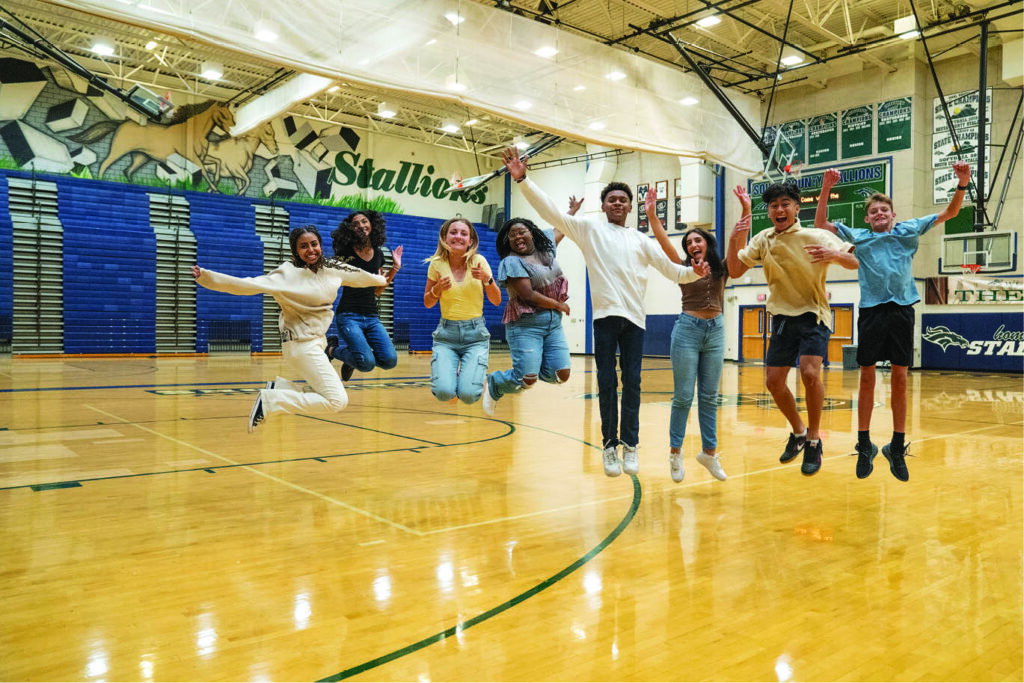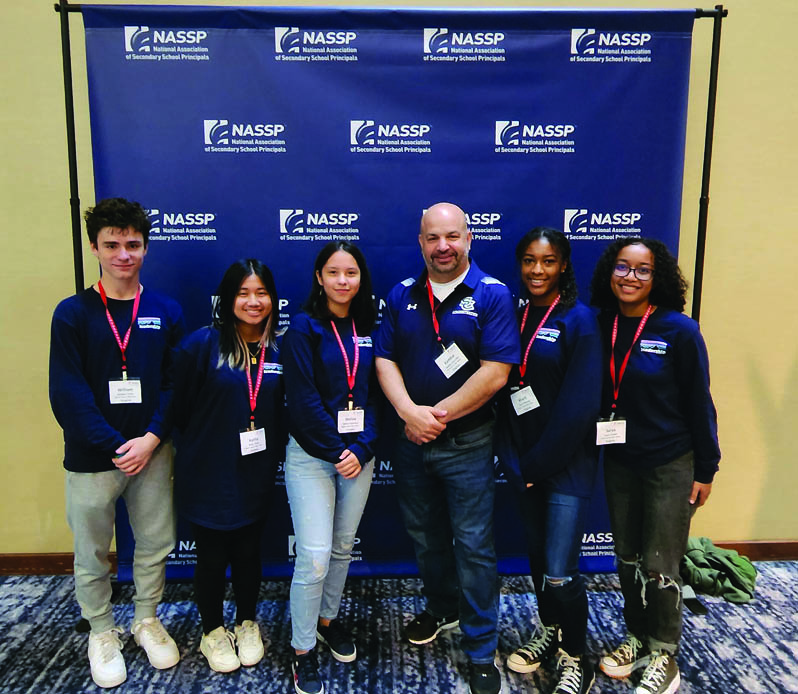Growing the Circle

In my first 25 years in public education, all of my experiences were in one school district. My circle of reference and data points were all clustered together. I was fortunate that this cluster of experiences was in one of the most successful school districts in the state of Virginia: Chesapeake.
However, in the last couple of years, I started looking for something different. I wanted to grow my circle of perspective to better understand and be more inclusive of other cultures. In much the same way that we want to grow our school circles to reach as many cultures as possible (and thereby allow more students to feel seen and heard), I felt the need to serve cultures outside of those to which I had grown accustomed.
So, in June of 2022, I packed up my office belongings and traveled three hours north to the largest school district in our state: Fairfax County Public Schools (FCPS). I landed at South County (SoCo) High School, the most diverse school in which I had ever worked. This transition was coupled with a change in levels of leadership, as I had moved from a middle school (grades 6–8) to a high school (grades 9–12). What follows is a reflection on the similarities and differences I’ve experienced in just the first several months of this change.
Similarities: Getting “REV”-ed up!

Let’s be clear: In education, we are fighting the same battles. How do we raise test scores while also being sensitive to the social and emotional learning (SEL) needs of students and staff? How do we involve parents but not overtax their time with all of the help we need? How do we ensure that we are not going to the same staff members every time we have a new idea or initiative to implement when they are the only ones volunteering to help? No matter the school district or school level, much of the time we are doing very similar work.
As a first-year principal in FCPS, I knew I needed to move slowly with implementing new ideas. To be honest, that is not natural for me—at all. I tend to be impatient when I see areas to address, but I was dedicated to keeping my word that first year. I would only make changes that were imperative for school success.
To that end, I consciously chose to focus on three concepts that I like to think of as “REV”: Relationship-building, being Equity-minded with our practices, and listening intently to stakeholder Voice. These are all areas that directly impact school culture but do not cause heartburn for most stakeholders. These were also areas in which I had a wealth of experience within my former school district.

Relationship-building is something I consider to be the bedrock of leadership. People have to know that we as school leaders and educators care before they will ever care about how much we know. As I learned about the many student organizations at SoCo, I asked students and sponsors if I could join their activities. For example, I joined our volleyball team for preseason conditioning by working out with them in the school gym. I attended step team practice and learned a new step routine that we performed together at our first pep rally. I attended meetings of our various religious clubs to show each of them how much I appreciated and supported their respective faiths. The more of these types of activities I attended, the more connections that students and I made with one another, and at the end of the day, that is where I get the energy to do my life’s work.
My engagement in these activities had a two-fold benefit. First, I wanted to begin connecting with students so they could see me as a person and not just as their principal. Second, I wanted my staff to see how important relationships were in our school culture. I am hopeful that my actions will have made a positive impact on both students and staff by the end of this year.
The second focus, being equity-minded, had multiple layers as well. We needed to ensure that all students had fair access to our programs. Of course, this included academic programs but also athletics, clubs, and music, as well as school finances and events. For instance, while school board policy did not require us to provide time during the school day for prayer, I felt it was imperative that we did everything possible to meet the needs of our Muslim Student Association. My supervisor and I met with student leaders of this organization and their parents to learn about their culture and needs.
I also collaborated with my predecessor to learn his perspective and strategies in this area. He was generous with his knowledge and time. Within one week, we identified new processes, such as finding alternative locations and times for students to pray on school property. This approach helped them avoid needing to leave school to attend a mosque for prayer and allowed them to get to their classes more quickly. We also found various staff members who could sponsor this group of students. Other programs reviewed through an equity lens were our new student orientation, back-to-school night, and discipline practices (for the more frequently occurring student misconduct).
Our third priority was attention to stakeholder voice. There was already a rich history of listening to student and faculty voices at SoCo, and that was something that we needed to continue and, if possible, enhance. Separate advisory councils continued not only for students and staff, but we also created a version for parents as well. In the first semester, we focused our discussions on academic workloads, grading, school safety, and SEL, among other issues. To further enhance student voice, we also began our weekly “What’s Good in the Last 24” segments on social media, which allowed students to share something positive that happened in their lives in the past 24 hours. In addition, students participated in our “town hall” segments during lunch by responding with their devices to questions we posted on our TV screens in the building. We solicited their opinions on a range of topics, such as school spirit gear, school events, and how connected they felt at school.
Besides continuing our Faculty Advisory Council, we continued soliciting staff feedback with “Cookies with Khoshaba,” which enabled staff to spend 15 minutes one-on-one with me and share anything they wanted. Sometimes the conversations were personal, and other times they were professionally related. These optional meetings, held three times this year, helped me connect with staff in a meaningful way. Of course, having an open-door policy and being visible during all class changes have also helped to keep communication flowing between my administrative team and faculty.
Differences Are Our Strength
The most significant change I experienced in moving from Southeastern to Northern Virginia was the degree of diversity among the student body. Our demographics at SoCo are diverse indeed. Our current enrollment is as follows: 18% Asian, 24% Black, 16% Hispanic, 35% white, and 7% other. This latter category includes relatively large numbers of Middle Eastern, Ethiopian, and multiracial students. It goes without saying that as principals, we serve all students. Being Middle Eastern myself, I was pleasantly surprised by the number of students who approached me about my ethnicity and told me their stories.
From these conversations, I developed a deeper appreciation of the importance for students of color to see their ethnic background represented in places of leadership. The relationships that these students and I built from similar lived experiences reinforced the importance of connectedness. For example, many of my Middle Eastern students approached me and began discussions about our shared heritage. It was an instant conversation starter. Such relationships are paramount in creating a positive school culture, especially for marginalized groups of students. It has become crystal clear that students not only need effective leaders in their lives, but they also need to see people who look like them in positions of school authority—people who can more clearly empathize with the hurdles they face.
Another difference between the two school districts and levels is the class schedule. At SoCo, we have 90-minute classes on alternating days. This schedule allows for students to take seven courses, with an every-other-day “advisory” bell. This advisory time is particularly relevant in supporting SEL. Students spend the first 30 minutes discussing SEL matters, and the remaining hour is spent working on academics (for those in need) or study hall (for those who are caught up on their coursework).
The other remarkable difference between my new and former school district is the organizational structure. In addition to my four assistant principals, my administrative team consists of a director of student (counseling) services, director of student activities (for athletics, clubs, and extracurricular events), a system of supports adviser (for supporting students who have a history of struggling), a dean of students (who primarily specializes in supporting students with attendance issues), and my administrative assistant. This deep leadership structure, combined with our Instructional Council (composed of department chairs), makes for a team of which even the (DC Comics) Justice League would be envious!
Grow Your Circle
I hope that my story inspires you as a school leader to “grow your circle.” Whether that means changing schools, changing school levels, or changing school districts is a personal choice. But we must continue to evolve if we aspire to be lifelong learners. I want to acknowledge that change is hard—and it can be scary. To make a change, we must have courage and a clear vision of not only what we were meant to do in our profession, but what our real calling is in life.
I encourage all of you to look deeply into your soul to find the answer to this question. There will be doubts and doubters. There will be challenges that you must fight through to discover the new you and your renewed purpose. To do so, I encourage you to keep the faith, fan the flame of your true passion, and never give up the fight. There are battles to be fought, and we are enough to meet them head-on.
S. Kambar Khoshaba is the principal of South County High School in Lorton, VA, and the former principal of Western Branch Middle School in Chesapeake, VA.
